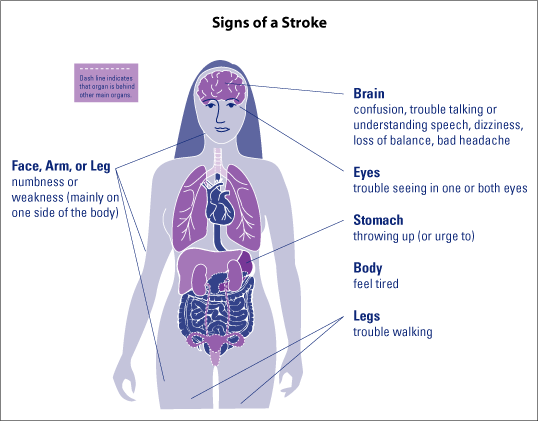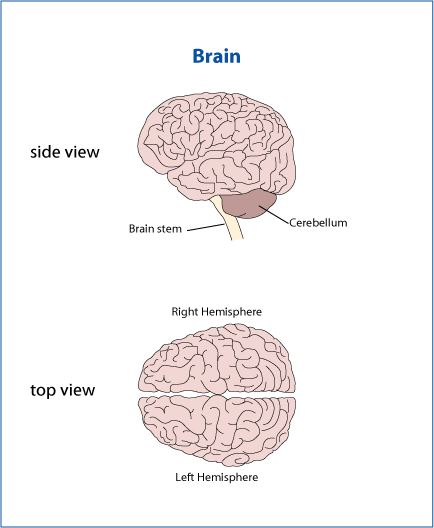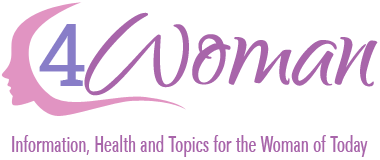Stroke
- What is a stroke?
- What is a "mini-stroke"?
- What are the signs of a stroke?
- How is stroke diagnosed?
- What are the effects of stroke?
- Who is at risk for stroke?
- How do I prevent a stroke?
- Should I take a daily aspirin to prevent stroke?
- Does taking birth control pills increase my risk for stroke?
- Does using the birth control patch increase my risk for stroke?
- How is stroke treated?
- What about rehabilitation?
See also...
A 911 Call Saved My Life

When I walked into the locker room at work, I realized something was wrong. I couldn't speak. I tried to pick up my lock, but my right hand couldn't grab it. One of my co-workers noticed something was wrong and asked if I could write. With my left hand, I scribbled 911 on a piece of paper. Luckily, my friend knew the signs of stroke and got help. She called an ambulance, and I was rushed to the emergency room. The doctors ran some tests and put a drug into my IV. Within 10 minutes I could speak again. I didn't know a thing about stroke before I had one. Now, I make sure that all my family knows the signs of stroke so they can get help if they need it.
What is a stroke?
A stroke is sometimes called a "brain attack." A stroke can injure the brain like a heart attack can injure the heart. A stroke occurs when part of the brain doesn't get the blood it needs.
There are two types of stroke:
- Ischemic stroke (most common type) -- This type of stroke happens when blood is blocked from getting to the brain. This often happens because the artery is clogged with fatty deposits (atherosclerosis) or a blood clot.
- Hemorrhagic stroke -- This type of stroke happens when a blood vessel in the brain bursts, and blood bleeds into the brain. This type of stroke can be caused by an aneurysm -- a thin or weak spot in an artery that balloons out and can burst.
Both types of stroke can cause brain cells to die. This may cause a person to lose control of their speech, movement, and memory. If you think you are having a stroke, call 911.
What is a “mini-stroke”?
A “mini-stroke”, also called a transient ischemic attack or (TIA), happens when, for a short time, less blood than normal gets to the brain. You may have some signs of stroke or you may not notice any signs. A “mini-stroke” lasts from a few minutes up to a day. Many people do not even know they have had a stroke. A “mini-stroke” can be a sign of a full stroke to come. If you think you are having a “mini-stroke”, call 911.
What are the signs of a stroke?
A stroke happens fast. Most people have two or more signs.
The most common signs are:
- Sudden numbness or weakness of face, arm, or leg (mainly on one side of the body)
- Sudden trouble seeing in one or both eyes
- Sudden trouble walking, dizziness, or loss of balance
- Sudden confusion or trouble talking or understanding speech
- Sudden bad headache with no known cause
Women may have unique symptoms:
- Sudden face and arm or leg pain
- Sudden hiccups
- Sudden nausea (feeling sick to your stomach)
- Sudden tiredness
- Sudden chest pain
- Sudden shortness of breath (feeling like you can’t get enough air)
- Sudden pounding or racing heartbeat
If you have any of these symptoms, call 911.

How is stroke diagnosed?
The doctor will usually start by asking the patient what happened and when the symptoms began. Then the doctor will ask the patient some questions to see if she or he is thinking clearly. The doctor also will test the patient's reflexes to see if she or he may have had any physical damage. This helps the doctor find out which tests are needed.
The doctor may order one or more of the following tests:
- Imaging tests that give a picture of the brain. These include CT (computed tomography) scanning, sometimes called CAT scans and MRI (magnetic resonance imaging) scanning. CT scans are useful for finding out if a stroke is caused by a blockage or by bleeding in the brain.
- Electrical tests, such as EEG (electroencephalogram) and an evoked response test to record the electrical impulses and sensory processes of the brain.
- Blood flow tests, such as Doppler ultrasound tests, to show any changes in the blood flow to the brain.
What are the effects of stroke?
It depends on the type of stroke, the area of the brain where the stroke occurs, and the extent of brain injury. A mild stroke can cause little or no brain damage. A major stroke can cause severe brain damage and even death.
A stroke can occur in different parts of the brain. The brain is divided into four main parts: the right hemisphere (or half), the left hemisphere (or half), the cerebellum, and the brain stem.

A stroke in the right half of the brain can cause:
- Problems judging distances - The stroke survivor may misjudge distances and fall or be unable to guide her hands to pick something up.
- Impaired judgment and behavior - The stroke survivor may try to do things that she should not do, such as driving a car.
- Short-term memory loss - The stroke survivor may be able to remember events from 30 years ago, but not what she ate for breakfast that morning.
A stroke in the left half of the brain can cause:
- Speech and language problems - The stroke survivor may have trouble speaking or understanding others.
- Slow and cautious behavior - The stroke survivor may need a lot of help to complete tasks.
- Memory problems - The stroke survivor may not remember what she did ten minutes ago or she may have a hard time learning new things.
A stroke in the cerebellum, or the part of the brain that controls balance and coordination, can cause:
- Abnormal reflexes of the head and upper body
- Balance problems
- Dizziness, nausea (feeling sick to your stomach), and vomiting
Strokes in the brain stem are very harmful because the brain stem controls all our body's functions that we don't have to think about, such as eye movements, breathing, hearing, speech, and swallowing. Since impulses that start in the brain must travel through the brain stem on their way to the arms and legs, patients with a brain stem stroke may also develop paralysis, or not be able to move or feel on one or both sides of the body.
In many cases, a stroke weakens the muscles, making it hard to walk, eat, or dress without help. Some symptoms may improve with time and rehabilitation or therapy.
Who is at risk for stroke?
It is a myth that stroke occurs only in older adults. A person of any age can have a stroke. But, stroke risk does increase with age. For every 10 years after the age of 55, the risk of stroke doubles, and two-thirds of all strokes occur in people over 65 years old. Stroke also seems to run in some families. Stroke risk doubles for a woman if someone in her immediate family (mom, dad, sister, or brother) has had a stroke.
Compared to white women, African American women have more strokes and have a higher risk of disability and death from stroke. This is partly because more African American women have high blood pressure, a major stroke risk factor. Women who smoke or who have high blood pressure, atrial fibrillation (a kind of irregular heart beat), heart disease, or diabetes are more likely to have a stroke. Hormonal changes with pregnancy, childbirth, and menopause are also linked to an increased risk of stroke.
How do I prevent a stroke?
Experts think that up to 80% of strokes can be prevented. Some stroke risk factors cannot be controlled, such as age, family history, and ethnicity. But you can reduce your chances of having a stroke by taking these steps:
- Know your blood pressure. Your heart moves blood through your body. If it is hard for your heart to do this, your heart works harder, and your blood pressure will rise. People with high blood pressure often have no symptoms, so have your blood pressure checked every 1 to 2 years. If you have high blood pressure, your doctor may suggest you make some lifestyle changes, such as eating less salt (DASH Eating Plan) and exercising more. Your doctor may also prescribe medicine to help lower your blood pressure.
- Don't smoke. If you smoke, try to quit. If you are having trouble quitting, there are products and programs that can help:
- Nicotine patches and gums
- Support groups
- Programs to help you stop smoking
- Get tested for diabetes. People with diabetes have high blood glucose (often called blood sugar). People with high blood sugar often have no symptoms, so have your blood sugar checked regularly. Having diabetes raises your chances of having a stroke. If you have diabetes, your doctor will decide if you need diabetes pills or insulin shots. Your doctor can also help you make a healthy eating and exercise plan.
- Get your cholesterol and triglyceride levels tested. Cholesterol is a waxy substance found in all parts of your body. When there is too much cholesterol in your blood, cholesterol can build up on the walls of your arteries. Cholesterol can clog your arteries and keep your brain from getting the blood it needs. This can cause a stroke. Triglycerides are a form of fat in your blood stream. High levels of triglycerides are linked to stroke in some people. People with high blood cholesterol or high blood triglycerides often have no symptoms, so have your blood cholesterol and triglyceride levels checked regularly. If your cholesterol or triglyceride levels are high, talk to your doctor about what you can do to lower them. You may be able to lower your cholesterol and triglyceride levels by eating better and exercising more. Your doctor may prescribe medication to help lower your cholesterol.
- Maintain a healthy weight. Being overweight raises your risk for stroke. Calculate your Body Mass Index (BMI) to see if you are at a healthy weight. Eat a healthy diet and exercise at a moderate intensity for at least 30 minutes most days of the week. Start by adding more fruits, vegetables, and whole grains to your diet. Take a brisk walk on your lunch break or take the stairs instead of the elevator.
- If you drink alcohol, limit it to no more than one drink (one 12 ounce beer, one 5 ounce glass of wine, or one 1.5 ounce shot of hard liquor) a day.
- Find healthy ways to cope with stress. Lower your stress level by talking to your friends, exercising, or writing in a journal.
Should I take a daily aspirin to prevent stroke?
Aspirin may be helpful for women at high risk, such as women who have already had a stroke. Aspirin can have serious side effects and may be harmful when mixed with certain medications. If you're thinking about taking aspirin, talk to your doctor first. If your doctor thinks aspirin is a good choice for you, be sure to take it exactly as your doctor tells you to.
Does taking birth control pills increase my risk for stroke?
Taking birth control pills is generally safe for young, healthy women. But birth control pills can raise the risk of stroke for some women, especially women over 35; women with high blood pressure, diabetes, or high cholesterol; and women who smoke. Talk with your doctor if you have questions about the pill.
If you are taking birth control pills, and you have any of the symptoms listed below, call 911:
- Eye problems such as blurred or double vision
- Pain in the upper body or arm
- Bad headaches
- Problems breathing
- Spitting up blood
- Swelling or pain in the leg
- Yellowing of the skin or eyes
- Breast lumps
- Unusual (not normal) heavy bleeding from your vagina
Does using the birth control patch increase my risk for stroke?
The patch is generally safe for young, healthy women. The patch can raise the risk of stroke for some women, especially women over 35; women with high blood pressure, diabetes, or high cholesterol; and women who smoke.
Recent studies show that women who use the patch may be exposed to more estrogen (the female hormone in birth control pills and the patch that keeps users from becoming pregnant) than women who use the birth control pill. Research is underway to see if the risk for blood clots (which can lead to heart attack or stroke) is higher in patch users. Talk with your doctor if you have questions about the patch.
If you are using the birth control patch, and you have any of the symptoms listed below, call 911:
- Eye problems such as blurred or double vision
- Pain in the upper body or arm
- Bad headaches
- Problems breathing
- Spitting up blood
- Swelling or pain in the leg
- Yellowing of the skin or eyes
- Breast lumps
- Unusual (not normal) heavy bleeding from your vagina
How is stroke treated?
Strokes caused by blood clots can be treated with clot-busting drugs such as TPA, or tissue plasminogen activator. TPA must be given within three hours of the start of a stroke to work, and tests must be done first. This is why it is so important for a person having a stroke to get to a hospital fast.
Other medicines are used to treat and to prevent stroke. Anticoagulants, such as warfarin, and antiplatelet agents, such as aspirin, block the blood's ability to clot and can help prevent a stroke in patients with high risk, such as a person who has atrial fibrillation (a kind of irregular heartbeat).
Surgery is sometimes used to treat or prevent stroke. Carotid endarterectomy is a surgery to remove fatty deposits clogging the carotid artery in the neck, which could lead to a stroke. For hemorrhagic stroke, a doctor may perform surgery to place a metal clip at the base of an aneurysm (a thin or weak spot in an artery that balloons out and can burst) or remove abnormal blood vessels.
What about rehabilitation?
Rehabilitation is a very important part of recovery for many stroke survivors. The effects of stroke may mean that you must change, relearn, or redefine how you live. Stroke rehabilitation is designed to help you return to independent living.
Rehabilitation does not reverse the effects of a stroke. Its goals are to build your strength, capability, and confidence so you can continue your daily activities despite the effects of your stroke. Rehabilitation services may include:
- Physical therapy to restore movement, balance, and coordination
- Occupational therapy to relearn basic skills such as bathing and dressing
- Speech therapy to relearn how to talk
For more information...
For more information on stroke, contact the National Women's Health Information Center (NWHIC) at 1-800-994-9662 or the following organizations:
National Institute of Neurological Disorders and Stroke
Phone Number(s): (800) 352-9424
Internet Address: http://www.ninds.nih.gov/
National Heart, Lung, and Blood Institute
Phone Number(s): (301) 592-8573
Internet Address: http://www.nhlbi.nih.gov/index.htm
National Stroke Association
Phone Number(s): (800) 787-6537
Internet Address: http://www.stroke.org/

